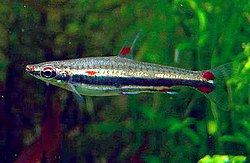| Lebiasinidae | |
|---|---|
 | |
| Nannostomus trifasciatus | |
| Scientific classification | |
| Kingdom: | Animalia |
| Phylum: | Chordata |
| Class: | Actinopterygii |
| Order: | Characiformes |
| Suborder: | Characoidei |
| Family: | Lebiasinidae Gill, 1889 [1] |
| Subfamilies | |
see text | |
The Lebiasinidae are a family of freshwater fishes found in Costa Rica, Panama, and South America. They are usually small and are known as ornamental fishes in aquaria, including popular fishes such as the various pencilfish and the splashing tetra.
Lebiasinids are small, cylindrical fish, ranging from 2 to 18 cm (0.8 to 7.1 in) in adult length. They prey on insect larvae, especially those of mosquitos. The family includes the voladoras (genera Lebiasina and Piabucina ), mostly found in highlands of the north Andes, the Guiana Shield and Central America, but the other species are mainly lowland fish inhabiting the Orinoco, Amazon and Paraguay River basins, and rivers of the Guianas. [2]